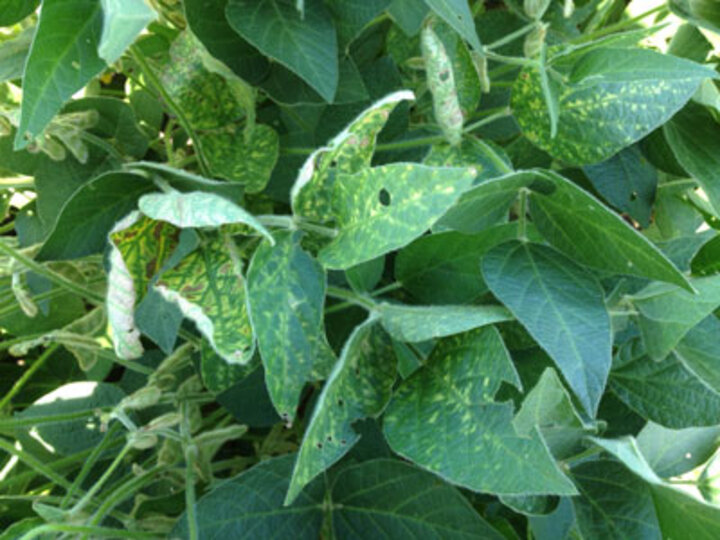| Table 1: Effect of various management factors on soybean yield. | ||
| Rank | Management Factor | Yield (bu/ac) Difference |
| 1 | Variety selection* | 15 |
| 2 | Planting date | 8 |
| 3 | Weed control** | 8 |
| 4 | Phosphorus fertility | 5 |
| 6 | Crop rotation | 5 |
| 5 | Row spacing*** | 3 |
| 6 | Seeding rate | 3 |
| *Three-year average performance difference among varieties from 2011-2013 in South Dakota State University trials. ** One week delay in weed control on 30-inch rows ***Multi-state study from 2009-2011 funded by the United Soybean Board, led by Seth Naeve, University of Minnesota. |
||

Sept. 12, 2014
Soybean variety selection is the earliest routine management decision farmers make and one of the most important. Variety trials in the Great Plains show a performance difference of 15 bu/ac among varieties (Table 1); if your yield difference potential is just half that, it equates to a revenue gain of about $75/ac. Compare this to the difference in price among varieties in a company lineup, which likely only varies by $9/unit.
Selecting the best variety is as good as the level of other management to control yield-limiting factors (Table 1). Recent analysis by University of Nebraska-Lincoln faculty show irrigated soybean yields in northeast Nebraska are not keeping pace with improvements in corn yield elsewhere in the state. Additional on-farm research targeted at identifying the causes for the inferior yield performance are needed.
Even though the combines have not started rolling yet, go ahead and capture those early seed discounts. Here is why. Seed companies have internal data showing the average performance difference among their products during previous seasons; these often include new varieties. They do consider such pervious performance in regional variety placement and do share this through variety recommendations in your region. Ask them if the supply for some varieties they recommend are a little tighter than others and consider booking those if they sound like a good choice for your farm. Choose a manageable number of varieties with your dealer(s) that appear to best fit your production style and farm ground. (It's your call on how many companies/seed dealers you want to work with when selecting varieties.) Then, once 2014 yield data are available from third party and company trials, evaluate the varieties you ordered and see if you want to make a substitution. Your seed dealer(s) will make this substitution assuming seed supply exists, but please discuss this with them ahead of time.
There are other important considerations besides reported yield from a trial at a specific location or region since not all fields have the same yield-limiting factors. When selecting soybean varieties, also consider:
- Look for a proven yield record. Check your farm, third-party and company data. Referencing multiple years and multiple locations when possible. See the list of variety trial sources below. Not all companies participate in third-party trials nor are all varieties tested.
- Select a disease resistance package that matches the need for each field (SDS, SCN, Phytophthora, etc.). If you have a field with a history of Sudden Death Syndrome (Figure 1), soybean cyst nematodes, or other agronomic issues best managed through variety selection, consider this along with yield performance of varieties within trials, especially if the trial did not have these limitations.
- Use a range of maturities. For example, in east-central Nebraska, where maturity group 3.0 is average, plant varieties ranging from 2.4 to 3.6. Short periods of heat/drought for one to two weeks during August may impact the fuller season more or less than the shorter season variety, depending when or if it occurs.
- Match up traits with your management practices and on a field by field basis (for example, focus on lodging or standability rating in high fertility/irrigated fields).
In summary, it is not in your best interest to plant the whole farm to one variety in the seed tender. Watch this Market Journal episode on selecting 2015 soybean varieties.
University and other variety trials in the region to help with variety selection:
- University of Nebraska Variety Testing Program
- F.I.R.S.T Soybean Testing Program
- Iowa State University Crop Testing
- Kansas State University Soybean Performance Tests
- South Dakota State University Crop Performance Testing
- University of Missouri Variety Testing Program
Nathan Mueller, Cropping Systems and Agricultural Technologies Extension Educator
Roger Elmore, Extension Cropping System Specialist and Robert B. Daugherty Water for Food Institute Fellow
Teshome Regassa, Coordinator of UNL Crop Variety Testing Program
